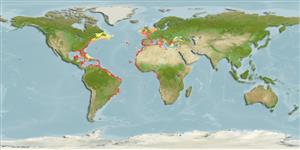Environment: milieu / climate zone / depth range / distribution range
Ecologie
marien; brak water; oceanodroom (Ref. 51243); diepte 1 - 150 m (Ref. 28173). Tropical; 56°N - 30°S, 92°W - 42°E
Atlantic Ocean: in tropical and subtropical waters, including the Mediterranean, Black Sea, Caribbean Sea and Gulf of Mexico. Highly migratory species
Lengte bij maturiteit / Grootte / Gewicht / Leeftijd
Maturity: Lm 41.8 range ? - 60 cm
Max length : 122 cm TL mannelijk / geslacht onbekend; (Ref. 26340); common length : 80.0 cm TL mannelijk / geslacht onbekend; (Ref. 5217); max. gepubliceerd gewicht: 16.5 kg (Ref. 40637); max. gerapporteerde leeftijd: 10 Jaren (Ref. 28173)
Dorsale stekels (totaal): 15 - 16; Dorsale zachte stralen (totaal): 11-13; Anale stekels 0; Anale zachte stralen: 11 - 15; Wervels: 39. Anterior spines of first dorsal fin much higher than the those mid-way, giving the fin a strongly concave outline. Interpelvic process small and bifid. Body naked except for corselet and lateral line. Swim bladder absent. Incipient protuberances on 33rd and 34th vertebrae. Back with broken oblique stripes (Ref. 168). Caudal peduncle with 7-8 finlets. Dark stripes on the back and with 3-7 dark spots between pelvic and pectoral fins (Ref. 35388).
Found in neritic waters close inshore (Ref. 13628). This schooling species is an opportunistic predator which feeds on virtually everything within its range, i.e. crustaceans, fishes (mainly clupeoid), squids, heteropods and tunicates. Eggs and larvae are pelagic (Ref. 6769). Specialized traps (madragues) are used in Tunisia and Morocco. Diving bird flocks may indicate large schools (Ref. 9710). Utilized fresh, dried-salted, smoked, canned and frozen (Ref. 9987). A popular game fish (Ref. 9710).
Eggs are shed in several batches when the water is warmest.
Collette, B.B. and C.E. Nauen, 1983. FAO Species Catalogue. Vol. 2. Scombrids of the world. An annotated and illustrated catalogue of tunas, mackerels, bonitos and related species known to date. Rome: FAO. FAO Fish. Synop. 125(2):137 p. (Ref. 168)
Status op de Rode Lijst van het IUCN (Ref. 130435)
Gevaar voor de mens
Reports of ciguatera poisoning (Ref. 30303)
Gebruik door de mens
Visserij: commercieel; sportvis: ja
Tools
Speciale rapporten
Download XML
Internetbronnen
Estimates based on models
Preferred temperature (Ref.
123201): 11.5 - 27.8, mean 23.3 °C (based on 1094 cells).
Fylogenetische diversiteitsindex (Ref.
82804): PD
50 = 0.6250 [Uniqueness, from 0.5 = low to 2.0 = high].
Bayesian length-weight: a=0.01000 (0.00866 - 0.01154), b=3.06 (3.02 - 3.10), in cm total length, based on LWR estimates for this species (Ref.
93245).
Trofisch niveau (Ref.
69278): 4.5 ±0.0 se; based on diet studies.
Weerstandsvermogen (Ref.
120179): Gemiddeld, minimale populatieverdubbelingstijd 1,4-4,4 jaar (K=0.13-0.22; tm=2; tmax=8; Fec=71,000).
Prior r = 0.57, 95% CL = 0.37 - 0.85, Based on 5 stock assessments.
Fishing Vulnerability (Ref.
59153): Moderate vulnerability (41 of 100).
Climate Vulnerability (Ref.
125649): Moderate vulnerability (40 of 100).
Nutrients (Ref.
124155): Calcium = 15.6 [6.9, 118.0] mg/100g; Iron = 1.86 [0.70, 4.94] mg/100g; Protein = 23.1 [21.1, 24.8] %; Omega3 = 0.228 [0.133, 0.398] g/100g; Selenium = 58.4 [30.9, 111.8] μg/100g; VitaminA = 24.3 [5.5, 105.8] μg/100g; Zinc = 0.487 [0.245, 1.888] mg/100g (wet weight); based on
nutrient studies.
